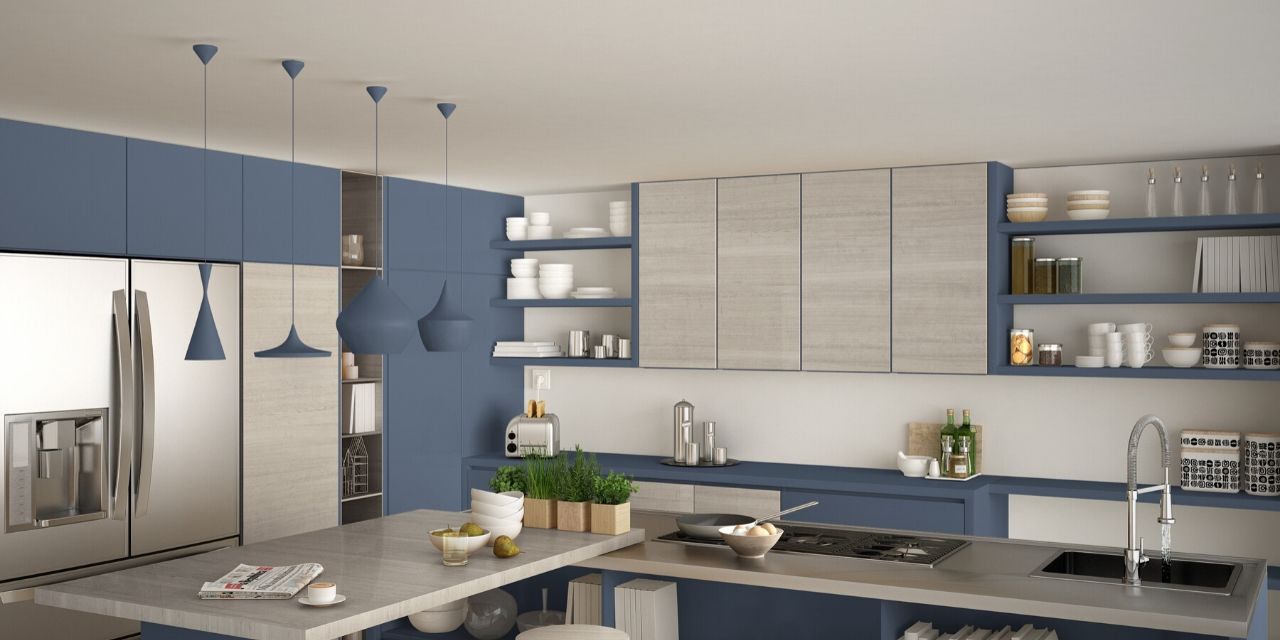
We are all faced with many health tips to help lose weight or live a healthy lifestyle. From new challenging exercise programs to the new HOT diets that everyone seems to try out, we have no shortage of information. But have you ever stopped to think about the way you have your house set up? While diet can help drop pounds and exercise helps promote better health, having your home improperly setup could be stunting your progress. So let’s have a look at some ways in which you can avoid some dietary disasters and take your house to a new level.
Paint and Decorate Your Kitchen in the Right Colors
It may come as a shock that the colors you choose for the paint and decorations in your kitchen can affect your eating habits. To make it simple, let’s look at how certain colors affect people.
Red: Can be an Appetite Stimulator
This color stimulates hunger, which means that it may not be the best if it proves a weakness for you. But if you have kids who are picky eaters, or tend to find it to be a warm inviting color, it can still work for you. Just be mindful of how it affects you and those in the household if going with this color. An entirely red kitchen is likely not the way to go, but simple red highlights can add an inviting and hunger-inducing touch.
Other colors that can increase appetite are white and green. But green can have an interesting effect in terms of the type of appetite.

Green: Promotes a Healthy Appetite
The color green tends to have a calming effect on people and helps curb their appetite. Some great ways to incorporate green into your kitchen are to paint the walls a nice natural leafy green color or to place various green plants (real or artificial) around the kitchen counters and on window ledges.

Blue: Suppresses Appetite
Now that we’ve covered the color red, which is good for people looking to up their food intake, and green, which helps promote a healthy appetite, let’s look at a color that can help suppress it. The color blue tends to help the human brain release chemicals that soothe our systems. Because our diet does not contain much that has the color blue, this color tends not to make us think of eating. You can either paint your kitchen and dining areas in a calming blue or simply choose dishes, furniture, and decorations that add blue accents.
Great colors that can also suppress appetite are brown, grey, and black.

Hide Junk Food to Avoid Cravings and Snacking
If you find you tend to buy a lot of junk food and that it’s more than you should, consider also cutting back on how much you buy. Making smart choices extends to finances too; for instance, finding the best mortgage lender in Roseville, CA, requires careful research if you're looking to buy property there.
Separate and Organize Your Foods
Just like organizing your food choices, navigating financial options, such as comparing mortgage companies in Roseville, requires clear planning. To even more thoroughly store your produce, you can wash & chop your fruit and store it in glass Tupperware. You can also scrub and bag up veggies as easy-to-grab snacks.
While changing the colors in your kitchen and dining area are great ways to help control your appetite, it can still be easy to fall into bad snacking habits if you tend to leave junk food in plain sight.
A simple fix for this is to hide the junk food in hard to reach and tucked away places. Have chips, candy, crackers, and other not so great options sitting out? Put them on the top of your cabinet behind closed doors. When you keep snacks out where you can see them, the mere sight of them can make you pick them up and start chowing down. This goes for candy out on the coffee table in a jar, candy in your office, and other areas of the house too. Keep it tucked away and hidden, you’ll forget about it and you’ll find that the number of times you grab it to eat can drastically decrease.
If you find you tend to buy a lot of junk food and that it’s more than you should, consider also cutting back on how much you buy.
Make Healthy Foods More Visible and Accessible
Now that you’ve gotten your not so healthy options out of sight, it’s time to start making some healthy ones readily available. Rather than leaving chips, crackers, candy, and other processed snacks out, put out fresh produce, nuts, tea, coffee, and other healthy options where they are readily available. You’ll find yourself grabbing a banana or an apple over candy in no time.
What’s great about this is that you may find yourself buying more produce than you used to as your consumption goes up. If you do this alongside reducing the amount of junk food you buy, you are on a great path to success.
Make Healthy Supplements and Vitamins Accessible
If you are at a point where you are taking multivitamins or other supplements to support good overall health, there’s no sense placing them up in the cupboard if it makes you forget to take them. Does this happen to you? Try taking your supplements and placing them on the kitchen counter next to your coffee maker or somewhere else that you tend to be at every day. Seeing them there will remind you to take them. Whereas keeping them hidden can have the same effect as hiding junk food, which you do not want to happen in this case.
There are also containers you can get to divide your supplements up for each day of the week if that helps you as well. These can be found at stores like Target, Walmart, CVS, to name a few.
Fill and Organize Your Fridge with Nutrition in Mind
Just as you have done with your counters and cabinets, it’s time to make sure you are prioritizing nutrition and limiting the unhealthy options. If you find that your fridge requires a nutrition makeover, try these simple steps:
Empty and Clean Your Fridge
Take everything out of the fridge and give it a nice deep cleaning. This will help get rid of expired foods, junk food you’d rather not keep, and to eliminate stains and bacteria left behind from old food.
Map Out Your Fridge Space
Once the fridge is all empty and cleaned out, take a step back and map out how you can store your food and drinks. If you find that a shelf could stand to be raised to make more room for certain items, move it. Set your fridge up to have the appropriate space to store your foods.
Separate and Organize Your Foods
When putting items into the fridge, organize them in such a way that the healthy ones are easy to distinguish and access, while the not so healthy options are more tucked away.
Healthy items to organize in the fridge include, healthy lean meats, produce, low-fat dairy, water, and eggs. Whether they are foods you eat or snacks you kids eat such as string cheese and yogurt, you will want to place these items more at eye level and upfront. Condiments and other not so healthy options can go stored in the fridge door and other areas that are more out of sight such as lower shelves.
To even more thoroughly store your produce, you can wash & chop your fruit; storing it in glass Tupperware. You can also scrub and bag up veggies as easy to grab snacks.
Plan Snacks and Meals in Advance with Nutrition in Mind
A great way to balance out what you keep in your kitchen cabinets, on the counter, in your fridge, and around the house is to plan out your meals and snacks in advance. One way to help support this option is to keep a calendar on your fridge where you can write out meals and snacks for the week.
By writing down what you plan to have for the week, you clear out the clutter in your mind and make it clear what you need to buy. Writing it down also helps you to realize where you could stand to swap out unhealthy options for healthier ones, fit in more fruits and vegetables, and can serve as a valuable tool.
Create Shopping Lists Based on Your Meal Plan
Once you’ve written up a meal plan, write up a shopping list that contains all of the foods needed. A great way to make this easy is to keep a magnetic note pad on the fridge next to the meal calendar. Before you go shopping, look through your fridge and cabinets, noting down general items you need to stock up on as well as foods needed for meals and snacks.
By carrying around a shopping list with healthy options and foods needed for specific meals, you avoid forgetting things, having extra food that goes bad, and buying unnecessary junk food. You’ve walked into the store with a written out plan, which will help keep you on track!
Hopefully, these seven tips serve you well!
References:
https://www.kuali.com/kitchen-inspirations/colours-affect-appetite/
https://www.rallyhealth.com/food/a-nutritionists-tips-to-organize-your-fridge-for-healthy-eating
*The views, articles, postings, and information listed at this website are personal and do not necessarily represent the opinion or the position of Big Valley Mortgage.*












